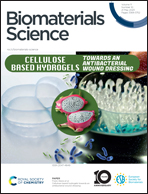Nanostructured ionic hydrogel with integrated conductivity, stretchability and thermal responsiveness for a high-performance strain and temperature sensor†
Abstract
Ionic conductive hydrogels are promising candidates for fabricating wearable sensors for human motion detection and disease diagnosis, and electronic skin. However, most of the existing ionic conductive hydrogel-based sensors primarily respond to a single-strain stimulus. Only a few ionic conductive hydrogels can respond to multiple physiological signals. Although some studies have explored multi-stimulus sensors, such as those detecting strain and temperature, the ability to identify the type of stimulus remains a challenge, which limits their applications. Herein, a multi-responsive nanostructured ionic conductive hydrogel was successfully developed by crosslinking the thermally sensitive poly(N-isopropylacrylamide-co-ionic liquid) conductive nanogel (PNI NG) with a poly(sulfobetaine methacrylate-co-ionic liquid) (PSI) network. The resultant hydrogel (PNI NG@PSI) was endowed with good mechanical stretchability (300%), resilience and fatigue resistance, and excellent conductivity (2.4 S m−1). Furthermore, the hydrogel exhibited a sensitive and stable electrical signal response and has a potential application in human motion detection. Moreover, the introduction of a nanostructured thermally responsive PNIPAAm network also endowed it with a sensitive and unique thermal-sensing ability to timely and accurately record temperature changes in the range of 30–45 °C, holding promise for application as a wearable temperature sensor to detect fever or inflammation in the human body. In particular, as a dual strain–temperature sensor, the hydrogel demonstrated an excellent capability of distinguishing the type of stimulus from superposed strain–temperature stimuli via electrical signals. Therefore, the implementation of the proposed hydrogel in wearable multi-signal sensors provides a new strategy for different applications, such as health monitoring and human–machine interactions.



 Please wait while we load your content...
Please wait while we load your content...